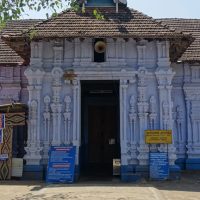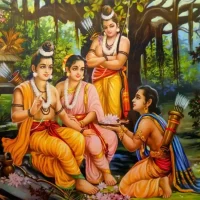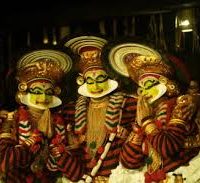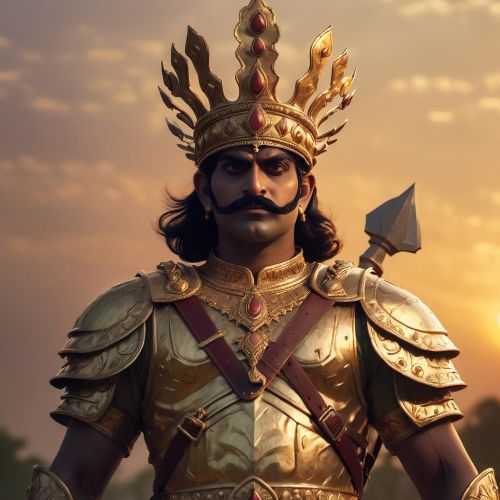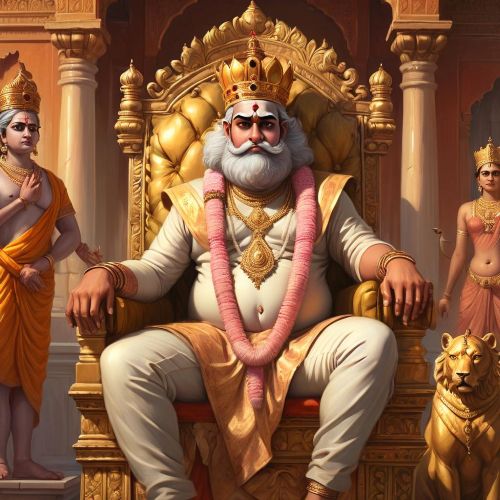Bharata : The Makeshift Emperor
Listen
At a glance
| Description | |
|---|---|
| Origin | Indian Mythology |
| Classification | Mortals |
| Family Members | Dasharatha (Father), Kaikeyi (Mother), Rama, Lakshmana, Shatrughna (Brothers) |
| Region | India |
| Associated With | Devotion, Royalty |
Bharata
Introduction
Bharata, the noble prince of Ayodhya and the younger brother of Lord Rama, is one of the most admired figures in the Indian epic Ramayana. Born to King Dasharatha and Queen Kaikeyi, Bharata represents selflessness, righteousness, and moral integrity. His story stands as a parallel narrative to Rama’s heroism—one that explores duty, devotion, and ethical governance. Unlike many mythological princes driven by ambition, Bharata renounced power and ruled Ayodhya as a custodian of dharma while waiting for Rama’s return. His character reflects the ideal balance between human emotion and divine duty, earning him a lasting place in Indian spiritual and cultural consciousness.
Physical Traits
In ancient depictions, Bharata is described as regal, tall, and composed, embodying the grace and strength of a warrior prince of the Ikshvaku dynasty. His countenance was marked by serenity and compassion rather than the fierceness of battle. Temples, murals, and classical art often portray him wearing royal garments and ornaments, carrying a staff or bow as symbols of his royal lineage. Unlike Rama, who is portrayed as a divine warrior, Bharata’s image reflects calm dignity—a prince whose physical strength was guided by wisdom and humility. His peaceful demeanor and controlled gestures symbolize his mastery over desires and emotions, aligning his outward appearance with his inner virtue.
Family
Bharata was born into the illustrious Raghu dynasty, as the son of King Dasharatha and his second queen, Kaikeyi. His three brothers—Rama, Lakshmana, and Shatrughna—were born to Dasharatha’s other wives, Kaushalya and Sumitra. Bharata shared an especially close bond with Shatrughna, often seen as his companion and confidant in the Ramayana. His wife, Mandavi, was the daughter of King Kushadhvaja, making her a cousin of Sita, Rama’s wife. The couple had two sons, Taksha and Pushkala, who would later rule over the kingdoms of Takshashila and Pushkalavati.
However, Bharata’s most defining familial moment came during Rama’s exile. When Kaikeyi manipulated King Dasharatha into banishing Rama for fourteen years so that Bharata could ascend the throne, the young prince was devastated. Rejecting both the crown and his mother’s ambitions, Bharata journeyed to the forest to plead with Rama to return and claim his rightful place. When Rama refused, citing his duty to uphold their father’s promise, Bharata placed Rama’s sandals—symbolizing his authority—on the throne and ruled Ayodhya as a regent until Rama’s return. This act of humility became one of the most revered demonstrations of brotherly devotion in world literature.
Other names
Bharata is often referred to by several names and epithets that highlight his virtues and royal heritage. In Valmiki’s Ramayana, he is called Kaikeyi Putra Bharata (Bharata, son of Kaikeyi), emphasizing his maternal lineage. The name Bharata itself comes from the Sanskrit root bhar, meaning “to bear” or “to support,” a fitting reflection of his role as the one who upheld dharma and preserved the kingdom in Rama’s absence. He is also known as Bharata of Ayodhya to distinguish him from another legendary king, Bharata, the son of Dushyanta and Shakuntala, mentioned in the Mahabharata. Despite being two distinct figures, both Bharatas symbolize righteousness, integrity, and devotion to duty—traits that have become deeply embedded in the Indian cultural and moral imagination.
Powers and Abilities
Unlike divine incarnations such as Rama or Krishna, Bharata’s greatness did not stem from supernatural powers but from his unwavering moral compass. His strength lay in his unshakable adherence to dharma, even when faced with personal loss and emotional turmoil. Bharata’s decision to reject the throne that rightfully belonged to Rama showcased unparalleled integrity and humility. His moral courage was evident when he confronted his own mother, Kaikeyi, condemning her actions and seeking forgiveness from Rama.
Bharata’s leadership was rooted in compassion and responsibility. During Rama’s exile, he ruled Ayodhya not as a king but as a caretaker, maintaining peace, prosperity, and justice. His humility was so profound that he lived like an ascetic in Nandigrama, wearing simple clothes and sleeping on the floor, awaiting Rama’s return. His self-discipline and devotion made him a symbol of selfless leadership. In Indian philosophy, Bharata represents the ideal of nishkama karma—action performed without attachment to reward—an essential concept in the Bhagavad Gita and broader Hindu ethics.
Modern Day Influence
Bharata’s legacy transcends time, continuing to shape India’s moral, cultural, and national identity. The very name “Bharat,” used for the Republic of India, is derived from his name, symbolizing the ideals of unity, duty, and righteousness. In literature and performing arts, Bharata’s story has been retold for centuries through plays, poems, and devotional narratives. The annual Ramlila performances across India often include Bharata’s emotional reunion with Rama, a moment celebrated for its profound display of devotion and dharma.
In modern media, Bharata has been portrayed in television adaptations such as Ramayan (1987, 2008, and 2020), where his character is depicted as a moral anchor of the epic. His portrayal resonates with audiences as a reminder of ethical governance and humility in leadership. Political thinkers and educators frequently cite Bharata’s example in discussions about responsible power and servant leadership.
Philosophically, Bharata’s actions inspire spiritual and ethical reflections in both religious and secular contexts. He embodies the timeless lesson that true strength lies not in conquest or authority but in restraint, empathy, and moral clarity. Across generations, parents have narrated Bharata’s story to their children as a lesson in duty, love, and righteousness, ensuring that his ideals remain interwoven with India’s moral fabric.
Bharata’s influence extends beyond religion into civic identity. The concept of Bharat Mata (Mother India) is rooted in the same spirit of sacrifice and duty that Bharata personified. His actions continue to inspire leaders, reformers, and everyday citizens to act with conscience and compassion, emphasizing that the essence of leadership lies in service, not domination.
Related Images
Source
Hadaway, M. (2024, November 20). The Mahabharata’s Lessons on Family and Duty. Hindu Mythology Worldwide. https://hindu.mythologyworldwide.com/the-mahabharatas-lessons-on-family-and-duty/
Apam Napat. (2024). Exploring Mahabharata’s Characters and Archetypes. Apam-Napat: Hindu and Indian Mythology. https://apam-napat.com/mahabharata-s-characters-and-archetypes/
Indosapien. (2024, September 1). Influence of Indian Mythology in Modern Culture. India on the Rise. https://indiaontherise.com/influence-of-indian-mythology-in-modern-culture/
Valmiki. (2005). The Ramayana (R. Goldman, Trans.). Princeton University Press.
Narayan, R. K. (1972). The Ramayana: A Shortened Modern Prose Version of the Indian Epic. Penguin Classics.
Doniger, W. (2009). The Hindus: An Alternative History. Oxford University Press.
Pattanaik, D. (2010). Jaya: An Illustrated Retelling of the Mahabharata. Penguin Books India.
Goldman, R. P., & Sutherland Goldman, S. (2022). The Ramayana: A Shortened Modern Prose Version of the Indian Epic. University of Chicago Press.
Wisdomlib. (2024, December 1). Bharata the son: Significance and symbolism. https://www.wisdomlib.org/concept/bharata-the-son
Shriprasadam Online. (2025, August 30). Lord Rama and His Four Brothers: Names, Story & Significance. https://shriprasadam.online/blogs/news/lord-rama-and-his-four-brothers-names-story-significance
Mahavidya. (2020, May 22). Bharata in the Ramayana. https://mahavidya.ca/2020/05/23/bharata-in-the-ramayana/
Exotic India Art. (2009, October 13). Bharata: Brother of Rama and Ocean of Virtues. https://www.exoticindiaart.com/article/bharata/
Ramayana. (2002, March 12). In Wikipedia. https://en.wikipedia.org/wiki/Ramayana
Wikipedia. (2005, December 7). Bharata (Ramayana). https://en.wikipedia.org/wiki/Bharata_(Ramayana)
Dharmapedia Wiki. (2016, December 31). Names of India. https://en.dharmapedia.net/wiki/Names_of_India
Frequently Asked Questions
What is lorem Ipsum?
I am text block. Click edit button to change this text. Lorem ipsum dolor sit amet, consectetur adipiscing elit. Ut elit tellus, luctus nec ullamcorper mattis, pulvinar dapibus leo.
What is lorem Ipsum?
I am text block. Click edit button to change this text. Lorem ipsum dolor sit amet, consectetur adipiscing elit. Ut elit tellus, luctus nec ullamcorper mattis, pulvinar dapibus leo.
What is lorem Ipsum?
I am text block. Click edit button to change this text. Lorem ipsum dolor sit amet, consectetur adipiscing elit. Ut elit tellus, luctus nec ullamcorper mattis, pulvinar dapibus leo.
What is lorem Ipsum?
I am text block. Click edit button to change this text. Lorem ipsum dolor sit amet, consectetur adipiscing elit. Ut elit tellus, luctus nec ullamcorper mattis, pulvinar dapibus leo.
What is lorem Ipsum?
I am text block. Click edit button to change this text. Lorem ipsum dolor sit amet, consectetur adipiscing elit. Ut elit tellus, luctus nec ullamcorper mattis, pulvinar dapibus leo.



